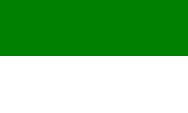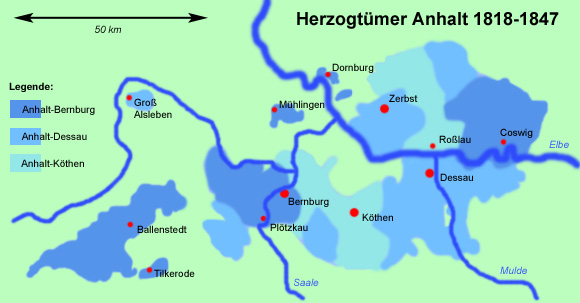• Flag
• Meaning/Origin of the Flag
• Coat of Arms
• Meaning/Origin of the Coat of Arms
• Map - The Duchies of Anhalt
• Numbers and Facts
• History
• Origin of the Country's Name

1815(?)–1853,
Flag of the country,
Quelle/Source: nach/by: Historisches Deutschland





The colors of the Ascanians were red, green and white, but in practice were used almost exclusively white and green, including the flags of the Duchies of Anhalt and their dynastic lines, which should have been furthermore square. The origin of the colors is unknown. It is believed that the red goes back to the red eagle of Brandenburg, the green to the octothorpe in the coat of arms of Saxony, and the white to the initial coat of arms of the Ascanians that showed the colors black and white. The cockades of the country showed only the color green.
Quelle/Source: Historisches Deutschland,
Hof- und Staatshandbuch für das Herzogtum Anhalt, Dessau 1887


17th/18th century, middle coat of arms of the Principality of Anhalt-Köthen,
Quelle/Source: nach/by:
Wikipedia (D),
Heraldique Europeenne

1806–1853,
lesser coat of arms Duchy of Anhalt-Köthen
Quelle/Source: nach/by:
Wikipedia (D)

1806–1853,
middle coat of arms of the Duchy of Anhalt-Köthen
Quelle/Source: nach/by: Wikipedia (D),
Heraldique Europeenne

All lines of the House of Anhalt used the same dynastic, middle coat of arms, and even the same lesser coat of arms. In the 18th century arose for Anhalt-Zerbst and Anhalt Köthen deviations in the middle coats of arms. Anhalt-Dessau and Anhalt-Bernburg retained their same shaped coats of arms.
The big coat of arms of the Duchy of Anhalt-Köthen is very abundantly partitioned and shows altogether twelve fields, which reflect the heraldic smithereens of the familie's lines or territorial acquisitions: Duchy of Saxony, Palatinate of Saxony, Duchy of Engern, Beringen, Ballenstedt, Askanien, Waldersee, Warmsdorf, Mühlingen, the red regalia field (display of blood jurisdiction) and Bernburg. In the middle of the coat of arms, over field no. 8, a heart-shield. That shows the smaller coat of arms a splited shield, to the left Brandenburg and on the right Saxony.
The Princes of Anhalt were initially even themselves the Margraves of Brandenburg and the Dukes of Saxony, but later even related by marriage with the Electors of Brandenburg and as well with those of Saxony, and claimed inheritance rights in both countries. They combined in their arms the crests of the two often feuding countries, in a so-called claim arms. In this way were not only combined the arms of Saxony and Brandenburg for Anhalt, but also the since 1863 in the Duchy of Anhalt used colours red, green and white are a combination of the colours of Saxony (white and green) and Brandenburg (red and white).
Quelle/Source: Heraldique Europeenne,
Volker Preuß


Quelle/Source: Volker Preuß

Area: ca. 283 square miles
Inhabitants: 39.000 (1846)
Capital: Köthen 6.300 inh. (1852)
Currency to 1840: 1 Taler = 24 Silbergroschen = 288 Pfg.
Currency to 1867: 1 Taler = 30 Silbergroschen = 360 Pfg.
Quelle/Source: Historisches Deutschland,
Der Michel

10th century · the family which was later referred as the Ascanians is mentioned in Swabia Gau
11th to 12th century · the Ascanians consolidate their possessions around the castles of Ballenstedt, Aschersleben and Anhalt
1157–1320 · the Ascanians are the Margraves of Brandenburg
1180–1422 · the Ascanians are the Dukes of Saxony
1252 · Birth of Henry I., he called itself as the first as "Prince of Anhalt"
1252 · inheritance, it arise the principalities of Anhalt-Aschersleben (until 1315), Anhalt-Bernburg (until 1468), Anhalt-Zerbst (until 1570)
1396 · inheritance of the Principality of Anhalt-Zerbst, it arise the principalities of Anhalt-Dessau and Anhalt-Köthen
1570 · death of Prince Bernhard of Anhalt-Zerbst, extinguish of all offshoot lines, Prince Joachim Ernst von Anhalt-Dessau rules over the entire Principality of Anhalt
1606 · inheritance of the Principality of Anhalt, it arise the Principalities of Anhalt-Dessau, Anhalt-Bernburg, Anhalt-Köthen and Anhalt-Zerbst
1665 · extinguish of the line of Anhalt-Köthen, the line of Anhalt-Plötzkau inherits the Principality of Anhalt-Köthen, arise of the line Anhalt-Köthen-Plötzkau
1765 · establish of the line of Anhalt-Köthen-Pless by Anhalt-Köthen-Plötzkau
1797 · the principality of Anhalt-Zerbst becomes splited between the principalities of Anhalt-Dessau, Anhalt-Bernburg and Anhalt-Köthen
1807 · joining tho the Rhine Confederation
1807 · Anhalt-Dessau and Anhalt-Köthen become levied to a Duchy by Napoléon
1815 · joining to the German Federation
1818 · extinguish of the line Anhalt-Köthen-Plötzkau, the Duchy of Anhalt-Köthen comes to the line of Anhalt-Köthen-Pless
1847 · extinguish of the in the Duchy of Anhalt-Köthen ruling line of Anhalt-Köthen-Pless, establish of a co-administration of the Duchies of Anhalt-Bernburg and Anhalt-Dessau for the Duchy of Anhalt-Köthen
1853 · annexation of the Duchy of Anhalt-Köthen to the Duchy of Anhalt-Dessau, establish of the Duchy of Anhalt-Dessau-Köthen

To explain the origin of the name "Anhalt" there exist various theories. It should point out to a castle, built by Esiko Count of Ballenstedt, without wood (on holt).
Quelle/Source: www.andat.de







![]()







